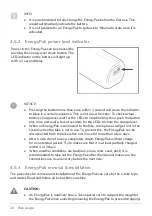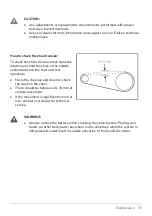
5 Transport
This chapter describes specific information regarding the e-bike (parts). Read the
information general owner's manual as well for general information on transport and
storage of the bike.
5.1 Transporting an e-bike
A common way that an e-bike is transported by users, is on the outside of an automobile,
in some way or form. The separate or removable (electronic) parts of the e-bike, such as
the charger and EnergyPak, should then always be transported separately from the bike.
Loose items inside the storage box, accessories, like bags and their contents, should also
be removed during transport.
CAUTION:
• Whatever the means of transport, always follow the instructions and
restrictions provided by the manufacturer(s) of the vehicle and/or bicycle
carrier used for transporting an e-bike.
• Batteries are not designed to be on the bike during transportation by
automobile. Batteries must be taken off the bike(s) and transported inside the
automobile.
NOTICE:
• Avoid transporting an e-bike in bad weather conditions. If this can't be
avoided, it is strongly advised to sufficiently cover any exposed electronic
parts. Higher speeds combined with wind and rain could cause moisture
to be pressured into the electronic parts, which can (temporarily) lead to
malfunctions. It may be necessary to allow the parts to dry by air when the
destination is reached.
5.2 Travel
If you plan to travel with your e-bike, make sure to prepare early. There are certain
regulations for transporting batteries and electronics on airplanes or other types of (public)
transportation. These regulations can vary by country, location and/or transport company.
Check the regulations and acquire any necessary documentation in advance. Your dealer
can provide assistance on getting the specific documentation for your e-bike.
32
Transport
















































